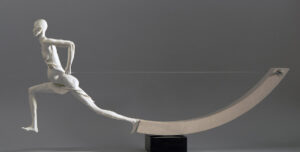
For the exhibit, “Architectures of the Body and the Built Environment: Impressions, Sensations and Expressions” at Galerie Pierre Léon Alliance Francaise, Toronto, January 11–February 4, 2017, Canadian sculptor W. Hung includes seven sculptures with heightened physical and metaphorical contrast: using “severe” architectural materials – steel, concrete, marble etc., – alongside expressive, polymer figures. With the differences in structures of forms laid bare, the question that surfaces when exploring the body of work is not the “why,” but the “why so much?” To answer this question an examination of Hung’s use of complementary elements, space and line, are required.
Empty space is essential to Hung’s sculptures: it divides and contains, and the combination, is powerful. Space demonstrates freedom and captivity, in the intersection of which are the ghostly-white figures. On the threshold of continuance or confinement these male forms, in sculptures such as, Indy Grab 2016, Purge Octahedron 2013, and Suspended Man 2011,display their most startling revelation: that the space in which they exist, is not independent of them, but an extension; an exoskeleton. That although man differs from the environment, the “impressions, sensations, and expressions” presented is to the degree in which the mutual effect of man, and man-made, is accepted. Space becomes supreme in each body’s–architectural and human–resistance in acceptance.
The figures in Hung’s sculptures resist their stolid surroundings with every last breath before being caste and frozen in time. They run (Pull 2012), tumble, (Purge Octahedron 2013), and scream (Suspended Man 2011) in vain; their struggle surviving in spirit, is at once physical and metaphysical. The outcome is unsettling and heart-breaking, as a futile fight usually is understood as the way of the martyr, poignantly depicted in Aftermath 2011.
But all is not lost. Life courses through where tension is made taut in Hung’s use of line. The nylon threads and steel wires in the sculptures connecting the figure to the architectural supports are active and dynamic, for what is tension if not alive?! Shards 2013 takes the concept further by including red thread–like blood traveling through vein between organs animate and inanimate, but all living–only to demonstrate; where there is contrast, life exists; and where there is great contrast, the empathy to coexist.
Natalie Shahinian. Toronto
Volume 32 no 6 July/August 2018 p 33

